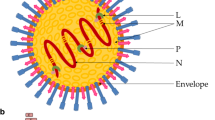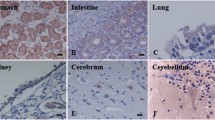Abstract
Canine distemper virus (CDV), a mobillivirus related to measles virus causes a chronic progressive demyelinating disease, associated with persistence of the virus in the central nervous system (CNS). CNS persistence of morbilliviruses has been associated with cell-to-cell spread, thereby limiting immune detection. The mechanism of cell-to-cell spread remains uncertain. In the present study we studied viral spread comparing a cytolytic (non-persistent) and a persistent CDV strain in cell cultures. Cytolytic CDV spread in a compact concentric manner with extensive cell fusion and destruction of the monolayer. Persistent CDV exhibited a heterogeneous cell-to-cell pattern of spread without cell fusion and 100-fold reduction of infectious viral titers in supernatants as compared to the cytolytic strain. Ultrastructurally, low infectious titers correlated with limited budding of persistent CDV as compared to the cytolytic strain, which shed large numbers of viral particles. The pattern of heterogeneous cell-to-cell viral spread can be explained by low production of infectious viral particles in only few areas of the cell membrane. In this way persistent CDV only spreads to a small proportion of the cells surrounding an infected one. Our studies suggest that both cell-to-cell spread and limited production of infectious virus are related to reduced expression of fusogenic complexes in the cell membrane. Such complexes consist of a synergistic configuration of the attachment (H) and fusion (F) proteins on the cell surface. F und H proteins exhibited a marked degree of colocalization in cytolytic CDV infection but not in persistent CDV as seen by confocal laser microscopy. In addition, analysis of CDV F protein expression using vaccinia constructs of both strains revealed an additional large fraction of uncleaved fusion protein in the persistent strain. This suggests that the paucity of active fusion complexes is due to restricted intracellular processing of the viral fusion protein.





Similar content being viewed by others
References
Appel MJG, Gillespie JH (1972) Canine distemper virus. In: Virology monographs. Springer, Vienna, New York, pp 1–96
Bollo E, Zurbriggen A, Vandevelde M, Fankhauser R (1986) Canine distemper virus clearance in chronic inflammatory demyelination. Acta Neuropathol (Berl) 72:69–73
Cathomen T, Mrkic B, Spehner D, Drillien R, Naef R, Pavlovic J, Aguzzi A, Billeter MA, Cattaneo R (1998) A matrix-less measles virus is infectious and elicits extensive cell fusion consequences for propagation in the brain. EMBO J 17:3899–3908
Cattaneo R, Rose JK (1993) Cell fusion by the envelope glycoproteins of persistent measles viruses which caused lethal human brain disease. J Virol 67:1493–1502
Cherpillod P, Beck K, Zurbriggen A, Wittek R (1999) Sequence analysis and expression of the attachment and fusion proteins of canine distemper virus wild-type strain A75/17. J Virol 73:2263–2269
Duprex WP, McQuaid S, Hangartner L, Billeter MA, Rima BK (1999) Observation of measles virus cell-to-cell spread in astrocytoma cells by using a green fluorescent protein-expressing recombinant virus. J Virol 73:9568–9575
Firsching R, Buchholz CJ, Schneider U, Cattaneo R, Meulen V ter, Schneider-Schaulies J (1999) Measles virus spread by cell-cell contacts: uncoupling of contact-mediated receptor (CD46) downregulation from virus uptake. J Virol 73:5265–5273
Hamburger D, Griot C, Zurbriggen A, Örvell C, Vandevelde M (1991) Loss of virulence of canine distemper virus is associated with a structural change recognized by a monoclonal antibody. Experientia 47:842–845
Johnston IC, Meulen V ter, Schneider-Schaulies J, Schneider-Schaulies S (1999) A recombinant measles vaccine virus expressing wild-type glycoproteins: consequences for viral spread and cell tropism. J Virol 73:6903–6915
Lawrence DM, Patterson CE, Gales TL, D'Orazio JL, Vaughn MM, Rall GF (2000) Measles virus spread between neurons requires cell contact but not CD46 expression, syncytium formation, or extracellular virus production. J Virol 74:1908–1918
McQuaid S, Cosby SL (2002) An immunohistochemical study of the distribution of the measles virus receptors, CD46 and SLAM, in normal human tissues and subacute sclerosing panencephalitis. Lab Invest 82:403–409
McQuaid S, Campbell S, Wallace IJ, Kirk J, Cosby SL (1998) Measles virus infection and replication in undifferentiated and differentiated human neuronal cells in culture. J Virol 72:5245–5250
Müller CF, Fatzer RS, Beck K, Vandevelde M, Zurbriggen A (1995) Studies on canine distemper virus persistence in the central nervous system. Acta Neuropathol 89:438–445
Peeples ME (1991) Paramyxovirus M proteins: pulling it all together and taking it on the road. In: Kingsbury DW (ed) The paramyxoviruses. Plenum Press, New York, pp 427–456
Plumb J, Duprex WP, Cameron CH, Richter-Landsberg C, Talbot P, McQuaid S. (2002) Infection of human oligodendroglioma cells by a recombinant measles virus expressing enhanced green fluorescent protein. J Neurovirol 8:24–34
Schmid A, Spielhofer P, Cattaneo R, Baczko K, Meulen V ter, Billeter MA (1992) Subacute sclerosing panencephalitis is typically characterized by alterations in the fusion protein cytoplasmic domain of the persisting measles virus. Virology 188:910–915
Schneider-Schaulies J, Niewiesk S, Schneider-Schaulies S, Meulen V ter (1999) Measles virus in the CNS: the role of viral and host factors for the establishment and maintenance of a persistent infection. J Neurovirol 5:613–622
Stern LBL, Greenberg M, Gershoni JM, Rozenblatt S (1995) The hemagglutinin envelope protein of canine distemper virus (CDV) confers cell tropism as illustrated by CDV and measles virus complementation analysis. J Virol 69:1661–1668
Von Messling V, Cattaneo R (2002) Amino-terminal precursor sequence modulates canine distemper virus fusion protein function. J Virol 76:4172–4180
Watanabe M, Wang A, Sheng J, Gombart AF, Ayata M, Ueda S, Hirano A, Wong TC (1995) Delayed activation of altered fusion glycoprotein in a chronic measles virus variant that causes subacute sclerosing panencephalitis. J Neurovirol 1:412–423
Wild TF, Buckland R (1995) Functional aspects of envelope-associated measles virus proteins. Curr Top Microbiol Immunol 191:51–64
Zurbriggen A, Yamawaki M, Vandevelde M (1993) Restricted canine distemper virus infection of oligodendrocytes. Lab Invest 68:277–284
Zurbriggen A, Graber HU, Wagner A, Vandevelde M (1995) Canine distemper virus persistence in the nervous system is associated with noncytolytic selective virus spread. J Virol 69:1678–1686
Acknowledgements
Grant number: Swiss National Science Foundation (31-58657.99)
Author information
Authors and Affiliations
Rights and permissions
About this article
Cite this article
Meertens, N., Stoffel, M.H., Cherpillod, P. et al. Mechanism of reduction of virus release and cell-cell fusion in persistent canine distemper virus infection. Acta Neuropathol 106, 303–310 (2003). https://doi.org/10.1007/s00401-003-0731-0
Received:
Revised:
Accepted:
Published:
Issue Date:
DOI: https://doi.org/10.1007/s00401-003-0731-0




